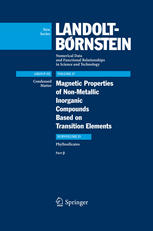

Most ebook files are in PDF format, so you can easily read them using various software such as Foxit Reader or directly on the Google Chrome browser.
Some ebook files are released by publishers in other formats such as .awz, .mobi, .epub, .fb2, etc. You may need to install specific software to read these formats on mobile/PC, such as Calibre.
Please read the tutorial at this link: https://ebookbell.com/faq
We offer FREE conversion to the popular formats you request; however, this may take some time. Therefore, right after payment, please email us, and we will try to provide the service as quickly as possible.
For some exceptional file formats or broken links (if any), please refrain from opening any disputes. Instead, email us first, and we will try to assist within a maximum of 6 hours.
EbookBell Team

4.8
44 reviewsThe Landolt-Börnstein Volume 27 deals with the magnetic properties of non-metallic inorganic compounds based on transition elements, such as there are pnictides, chalcogenides, oxides, halides, borates, and finally phosphates and silicates, the latter presented in this subvolume I. A preliminary survey of the contents of all subvolumes that have already appeared or have been planned to appear is printed on the inside of the front cover. The silicates are very complex systems, intensively studied in literature. They cover large classes of minerals as well as synthetic samples. In analyzing their magnetic and magnetically related properties we essentially followed the classification given by the Mineral Reference Manual (E. H. Nickel, N. C. Nickols, Van Nostrand Reinhold, 1991). Individual chapters are dedicated to orthosilicates, sorosilicates, cyclosilicates, inosilicate, phyllosilicates and tectosilicates. Due to the huge amount of data these chapters had to be spread over several subvolumes I1, I2, etc. . - In each chapter the different groups of minerals and synthetic silicates were distinctly analyzed in various sections. For each group, additional silicate minerals, more recently reported, as well as synthetic samples having related compositions and/or crystal structures were also considered. The silicates included in each section were firstly tabulated, mentioning their compositions. The solid solutions between the end member compounds were also described. The space groups and lattice parameters for most silicates were tabulated. Crystal structures of representative silicates were discussed in more detail and the atomic positions were given.